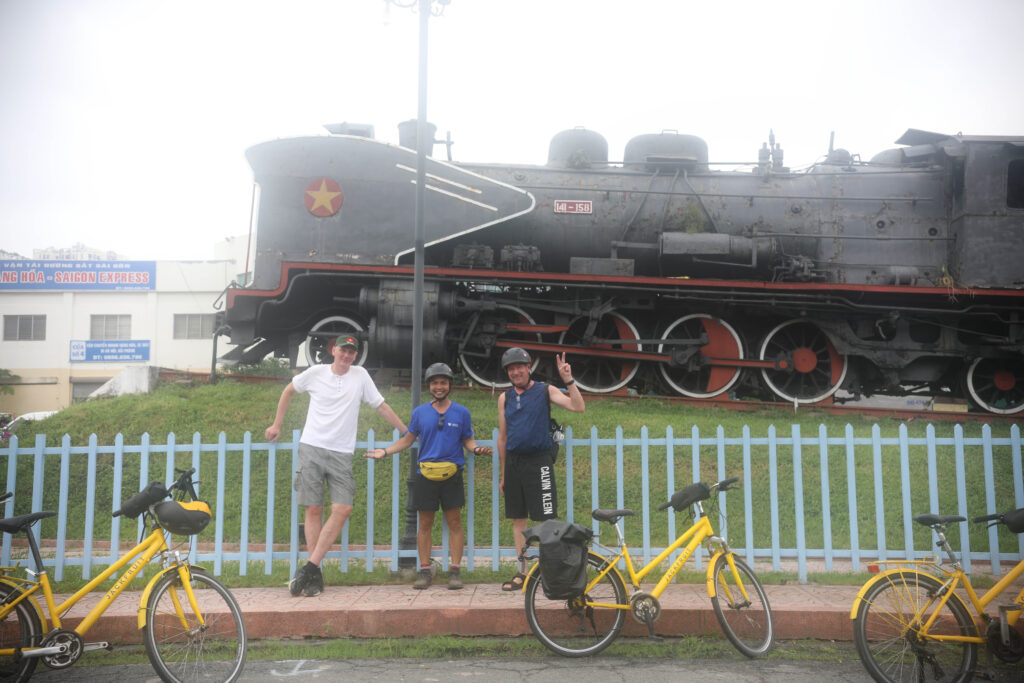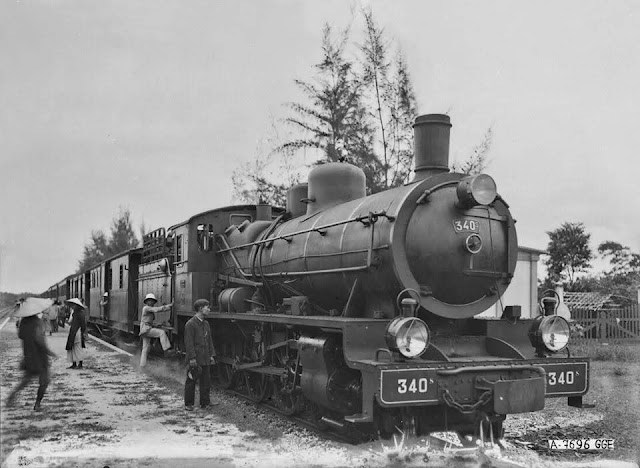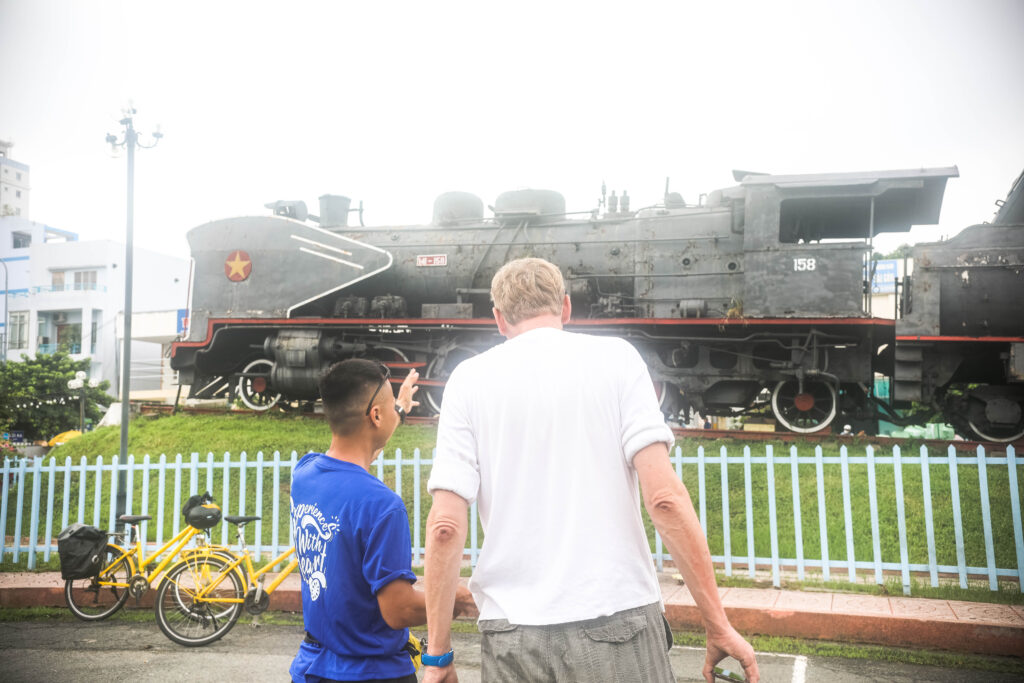Welcome to Ho Chi Minh City!

When you arrive in Ho Chi Minh City, you will not have difficulty finding a historical landmark to explore. You may have heard of the fame of Landmark 81, Independence Palace, Notre Dame Cathedral, and the Central Post Office. However, beyond these historical sites, there are still many other interesting places that also bear a significant historical imprint, such as the Saigon Train Track and Phu Chau Floating Temple. These two seemingly unrelated places actually share a common point, which is their existence for over hundreds of years – witnessing the many changes of Saigon from its early days to the modern city it is now.
Imagine on a beautiful day, you take a stroll along the train tracks to enjoy the peaceful morning sky and suddenly hear unexpected sounds from the passing train on the Saigon Train Track. In those moments, you will feel the rhythm of the train as if reflecting the heartbeat of the bustling city. Continuing along the railway lines, you will witness a temple floating on the water, you read that right, this is Phu Chau Floating Temple – a temple that is hundreds of years old.
The clear sky, cool breeze, and immersing yourself in untold stories are an indescribable feeling, a feeling that perhaps you have to experience firsthand to realize that “oh, so a true adventure is like this.” So don’t wait any longer, right below, Jackfruit will tell you about the special things at these two historical landmarks, where you will find the hidden beauty of an old Saigon.
Journey Along the Saigon Train Track
The Origins of the Railway in Vietnam
Going back to the late 19th century from the French colonial period in Vietnam. At that time, France set the goal to optimize the process of exploiting natural resources and promoting trade. To achieve this, France created a railway system to connect inland regions with coastal ports. This system allowed for faster and more efficient transportation of goods compared to traditional methods such as boats or carts.
In 1885, the first railway line in Vietnam was officially opened, the Saigon-My Tho railway (also known as the Saigon Train Track now). The railway line was about 70km long mainly to support the export of agricultural products such as rice and rubber from the Mekong Delta to Saigon. Following the success of the Saigon Train Track, the North-South railway project was inaugurated in 1902, extending to 1726 km from Hanoi to Saigon and vice versa. This laid the foundation for the expansion of railway lines throughout the country.
The development of railways not only contributed to the development of cities and towns along the railway lines but also played a role in cultural exchange, allowing people from different regions to travel and experience train journeys on various routes. However, everything was still unstable as the railway lines always faced challenges such as wars and urbanization, notably the Saigon Train Track from Saigon-My Tho had to undergo many ups and downs and had to be relocated numerous times to settle at its current location.

Significant Events That Shaped the Saigon Train Track
Up to now, Saigon station has been relocated a total of 3 times and has undergone countless historical changes. It was initiated in the late 19th century and opened in 1885 to serve as the first railway line in Indochina from Saigon to My Tho. This was also one of the important railway lines in the transportation history of Vietnam.
Initially, the first station serving the Saigon Train Track lines was located next to the Saigon River at Bach Dang pier, starting from Ham Nghi Street, passing through Pham Hong Thai Street and Le Thi Rieng Street, then to Cho Lon and stopping at My Tho. Shortly after, the Saigon-Nha Trang railway line was also established and started and followed the route of the Saigon-My Tho line. But after a while, the station became overloaded and could not serve both railway lines at the same time.
The colonial government at that time planned to build a larger station on the west side of Krantz-Duperré Avenue (now Ham Nghi Avenue), but this plan failed and instead a temporary replacement station was built at the intersection of Ham Nghi and Nam Ky Khoi Nghia to serve the Saigon-Nha Trang and Saigon-My Tho lines would continue to operate at the old Saigon station.

Until the Ben Thanh market was built on Krantz-Duperré Avenue, the government decided to merge both the Saigon – My Tho and Saigon – Nha Trang railway lines into a single station to the southwest of the market in 1911. The Saigon station was once again relocated here, with the Saigon train tracks to My Tho placed in the present-day 23/9 Park and the Saigon – Nha Trang line running towards Nguyen Thuong Hien Street. Throughout the 90s, this Saigon train track became a vital lifeline for transporting goods to the Saigon port and was considered the lifeline of Saigon at that time.


However, this was not yet the final location of the Saigon station. After the Saigon train track operated for a few years, issues arose, and the government began to realize that this new station was not truly optimal and significantly hindered some major traffic routes on the bustling avenue. Additionally, residents voiced concerns about the train tracks frequently becoming obstacles to their daily activities and work. Therefore, another relocation took place, but only the Saigon – Nha Trang line was moved to the city center, while the Saigon – My Tho line remained unchanged until 1958 when it temporarily operated until the country unified due to insufficient funding for relocation.

During this period, Vietnam was struggling for independence and enduring numerous bombings on the railway. Particularly after the general offensive during the 1968 Tet, maintaining the Saigon train track became increasingly unfeasible, and by 1971, all suburban and interurban railway services in Saigon were terminated.
In 1975, after the country was completely unified, the Vietnamese government officially restored all railway lines nationwide. Naturally, the Saigon train track was revived and began to be rebuilt from scratch, completed in 1983 on the former French airport area. After constructing the new train station at the new location, the old station site was removed and transformed into the 23/9 Park (commemorating the martyrs who died in the battle against the British-Indian forces aiding the French in reoccupying Saigon).

Today, the railway lines on the Saigon train track are still operational, welcoming passengers regularly. While some infrastructure facilities have deteriorated, the station has been renovated and upgraded to create a more spacious environment. Along the Saigon train track, passengers can admire the beautiful scenery of the Mekong Delta, lush green fields, and the romantic Mekong River.
- Address: 1 Nguyen Thong Street, Ward 9, District 3, Ho Chi Minh City
- Hours: 7 AM – 10 PM daily
- Click here to see a Google map from the Jackfruit office to Saigon Train Track

Riding Toward the Serene Phu Chau Floating Temple
Story historical surrounding the Phu Chau Floating Temple
When visiting Vietnam, you may have seen many floating houses on the water in certain river regions. But have you ever heard of a floating temple right in Ho Chi Minh City? Phu Chau Floating Temple is not a new temple; it has existed since the 18th century and is now over 300 years old. The temple is considered an enduring landmark with a rich historical imprint of Ho Chi Minh City, attracting many tourists to visit and admire its ancient beauty.

Being an ancient temple, there are many legends surrounding it. One legend tells of a fisherman who, centuries ago, caught a statue of Lady Thuy Te, which he brought back and, together with others, established a shrine for worship, regularly visiting to pray for favorable weather.
Another tale recounts that one night, a fisherman accidentally retrieved the body of a woman from an upstream source and buried her to rest in peace. This act of kindness and respect towards the deceased woman led to the fisherman’s prosperity, drawing attention from others who believed that saving a life was more valuable than building seven pagodas. The peaceful spirit of the deceased woman brought blessings to the land, prompting people from all around to stop and offer incense for good fortune at the grave, hoping for success in their fishing endeavors. Over time, people suggested contributing to building a larger shrine to protect against floods.

As the larger shrine, named Phu Chau Floating Temple, was constructed, more people were drawn to offer prayers for peace and prosperity for their families due to the temple’s sacredness. Even during the 1960s war period, the temple served as a hiding place for the Vietnamese military. However, after 1975, when the country achieved peace, Phu Chau Floating Temple gradually fell into disuse, with fewer visitors.


Witnessing this decline, Mr. Luc Cau (of Chinese descent) took the initiative to renovate the temple, restoring its grandeur as it stands today. Phu Chau Floating Temple embodies a unique blend of Vietnamese-Chinese architecture, with dragon statues surrounding the temple, creating an indescribable sense of wonder for visitors.

Architectural Features and Design of Phu Chau Floating Temple
Unlike the temples on the mainland, you need to take a boat across the river to get to Phu Chau floating temple. As soon as you step through the entrance gate, you will see a pair of dragons made of jade stone winding on the roof and a signboard engraved with the name “Phu Chau Temple” in both Vietnamese and Chinese. Not only on the roof, dragon statues also appear under the columns around the gate and along the path into the temple, totaling more than 100 dragon statues at Phu Chau floating temple.

In East Asian culture, especially in Vietnamese culture, besides being associated with water, dragons are also symbols of power, strength, and protection, seen as guardians for the people. Additionally, dragons are sacred creatures closely connected to the deities in the temple, creating a sense of the deities’ real presence in the temple.
Therefore, Phu Chau floating temple is divided into three main sections for worshiping the deities: the front hall, middle hall, and main hall. The statue of the tiger deity is worshiped right in front of the temple, the main hall is where the Mother Goddess of the Five Elements is worshiped, inside the main hall are the statues of the Great Saint, Lady of the Ninth Heaven, and the deities of metal, water, fire, earth, and wood. To the right of the main hall is the worship of General Guan, to the left is the worship of Bao Cong, and right in front is the altar for worshiping the local goddess Chau Doc and the Seven Ancestors.


Every day, Phu Chau floating temple is regularly cleaned and well-maintained to preserve the solemnity of the deities present here. These deities act as a thread that maintains the connection between humans and nature, ancestors, and social values, while also bringing peace, prosperity, and justice to the people. Therefore, every full moon of the first lunar month, the second lunar month, and the seventh lunar month, there are festivals at Phu Chau floating temple where visitors can come to pray for peace and enjoy the natural scenery of the temple, as well as release fish or birds.
- Address: 173/36/7B11 D. Quang Ham Street, Ward 5, Go Vap District, Ho Chi Minh City
- Hours: 7 AM – 5 PM
- Price: 15.000 VND for one ticket both ways
Explore more: 25 Unusual Things to Do in Ho Chi Minh City

Why Cycling is the Best Way to Explore?

To explore the tourist attractions in Ho Chi Minh City in general and Saigon Train Track and Phu Chau Floating Temple in particular, you have various options such as taxi, motorbike, joining a tour, or cycling. Unlike other means of transportation, with a bicycle, you will have a completely different experience with benefits such as:
Eco-Friendly Travel
The first benefit will definitely be environmentally friendly. Unlike motorbikes or cars that often emit CO2 – a gas that contributes to the greenhouse effect and climate change, as well as other gases like NOx, CO. These emissions not only affect air quality but can also pose health risks to humans and have negative impacts on the environment. Therefore, the use of environmentally friendly transportation like bicycles is increasingly encouraged. Furthermore, bicycles are lightweight and compact vehicles that do not require fuel. I believe that if you choose a bicycle as your companion throughout the journey, you will never regret it.

Flexibility and Freedom
If you are someone who dislikes constraints and loves freedom, cycling is a suitable choice for you. In a large city like Ho Chi Minh City, you can discover many beautiful and attractive places that you cannot access by car or public transportation, while a bicycle can take you through alleys where locals live, explore the distinctive culture of the Vietnamese people, hidden small islands, or floating markets, and floating temples like Phu Chau Temple. Can you believe that with just a bicycle, you can explore all the places mentioned above? Yes, you can! There are many things that a bicycle can take you to beyond what you think.

Immersive Experience
Do you like exploring hidden places along narrow paths? Do you enjoy strolls through streets as if you were on a boat slowly crossing a river? Do you like breathing in fresh air every early morning? If the answer is yes, then you must quickly embark on this journey by bicycle. A bicycle will give you all the experiences you desire and even more wonderful ones.
Moreover, if you do not have a driver’s license or are not confident in controlling vehicles like motorbikes or cars, it can be more dangerous, especially in a bustling city like Ho Chi Minh City where traffic is dense and hard to control. If you drive a car, you may get stuck in traffic for a period, disrupting your travel itinerary, especially in adverse weather conditions such as rain or strong winds, which can make it difficult to move and affect your travel experience.
On the contrary, a bicycle is the best choice if you do not have a driver’s license or are not confident in navigating a new city. A bicycle can be your companion to navigate through crowded streets and gently glide through small alleys, helping you explore the city more thoroughly, experience the surrounding environment authentically from sound, and scent to scenery – something that only cycling can make you feel the most romantic side of Saigon.

Connecting with the local community
Outside of appreciating the beauty of nature, you can also directly stop by a coffee shop or a restaurant to rest and chat with the locals, because Vietnamese people are always very friendly and hospitable, regardless of where you come from or your background, they are always ready to help and share their daily stories with you. Not only that, you can also participate in the daily activities of the locals such as singing karaoke, fishing, picking lotus, cooking, or even having a beer with them to socialize. Sounds interesting, right? It would be even more interesting if you could experience it firsthand.

Cost Effective
The essence of travel is exploration, and if you only explore one place in a long day, it’s not enough, but if you go to many places, it can be quite costly in terms of expenses like fuel, parking, and maintenance. So if you explore by bike at Jackfruit, you won’t have to worry about any of those costs. All you need to bring is a spirit of exploration and good health to be ready to ride a bike through all the streets in Ho Chi Minh City!

How to Get to Saigon Train Track and Phu Chau Floating Temple by Cycling?
When you read this far, you are probably quite anxious to find the most suitable itinerary to explore both the Saigon train track and the Phu Chau floating temple. No need to look far, Jackfruit Adventure will take you through all the roads where there are many untold historical stories. Starting from Cau Mong Ben Bach Dang, Jackfruit will take you through 23/9 Park and Ben Thanh Market, then to Nguyen Thong Ga Saigon Train Track, rest and explore the nostalgic Saigon at Nho Cafe, then continue to explore Phu Chau Floating Temple and return to the office of Jackfruit Adventure.




The special thing about this trip is that you will travel along the historical train lines that are still in operation, each place you pass through will be like a train car when you connect them together, it will be like a train of memories running through your mind every time you remember it, and all these memories will have Jackfruit’s bike accompanying you.
All itineraries, bikes, repair tools, helmets, or even medical supplies are prepared and ready for you by Jackfruit. And of course, there will be lovely tour guides accompanying you, so why hesitate any longer and not start your journey right away?

Let’s start your journey with Jackfruit Adventure!
At Jackfruit Adventure, we organize Ho Chi Minh City Cycling Tour and Team Building Ho Chi Minh. With a deep knowledge of Saigon City and local connections, we believe we can give you an awesome bonding time together. Contact us today if you have any requests or questions about preparing a trip for your team to bond in Ho Chi Minh, Vietnam.





